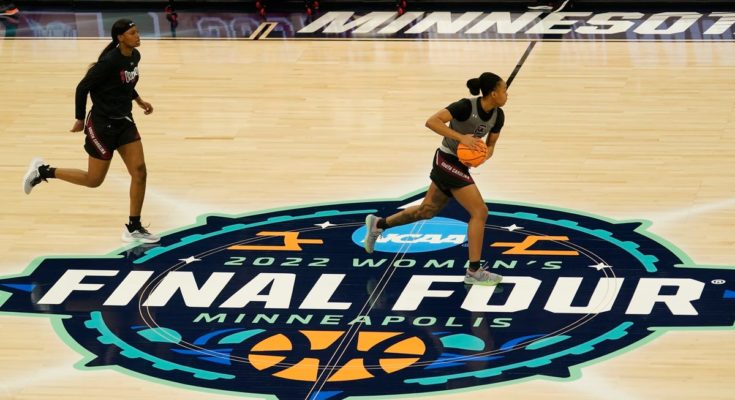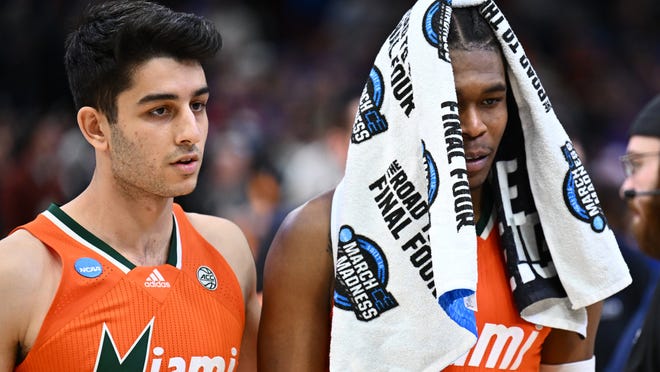Being good hasn’t been good enough to get equitable resources for the women’s basketball teams playing in the Final Four this weekend.
Every public school with a team still competing in this year’s NCAA women’s tournament has historically spent less money on its female basketball players than it did on its male players who didn’t advance this far.
The same is true of the schools that played in the Elite Eight in both the men’s and women’s tournament this year, as women’s teams have gotten fewer resources than the men’s teams at their home schools.
A first-of-its-kind analysis by USA TODAY examined spending across three categories – equipment, recruiting and travel – at 107 public schools in the NCAA’s Division I Football Bowl Subdivision. The analysis, done in collaboration with the Knight Newhouse Data Project at Syracuse University, used NCAA revenue and expense reports for the 2018-19 and 2019-20 seasons.
‘Read more: They’ve had 50 years to figure it out’ –Title IX disparities in major college sports haven’t gone away

Of the 16 teams that made it to this year’s men’s and women’s Elite Eight, 10 hailed from public schools whose spending data were included in the analysis.
Together, those 10 public schools spent $14.2 million – or 67% – more on their men’s teams than their women’s teams over the two seasons.
“It’s really disappointing, and it’s really discouraging to think that 50 years after Title IX, a federal law, that the law, number one, is not being enforced,” said Stanford women’s coach Tara VanDerveer. Data was not available at her school because it is private.
“We all have either sisters, daughters, nieces, women that are suffering because they’re not getting the resources or they’re not getting the support that they deserve. I call it hot dogs for the girls and steak for the boys. It will be a great time when you don’t need Title IX. But unfortunately in our world, there’s discrimination still against people, women, and we need to keep battling.”
Title IX is the landmark law that bans sex discrimination in education. Passed in 1972, it opened more opportunities for women in academics and athletics.
At some of the top schools, the large gaps remain.
Six of them spent $1 million more on their men’s team than their women’s. Indeed, all but South Carolina had spending gaps of more than $750,000.
Kansas’s men’s team more than doubled the spending of its women’s team. So did N.C. State, where the women are perennial contenders and were a No. 1 seed in this year’s tournament before falling to UConn in double overtime in a de facto home game for the Huskies in the Elite Eight.
DAN WOLKEN:Combining the men’s and women’s Final Four is an idea worth trying
“We’re well taken care of, that’s all I know,” said N.C. State women’s coach Wes Moore. “I have no clue what the men have or are getting. What I care about is that our women are well taken care of, and treated first-class, and they are.
“I’m not sure what other stuff might be missing.”
Those spending gaps were in line with the broader analysis of all 107 schools, which found that for every dollar schools spent on men’s basketball teams, they spent 63 cents on women in travel, equipment and recruiting.
The picture would be worse save for one outlier – South Carolina.
The Gamecocks’ women’s team, which won the 2017 national championship and is in its fourth Final Four under coach Dawn Staley, was one of a handful of teams to come close to parity with its men’s team.
“At South Carolina, our success has allowed us to probably hit the budget a little bit more than most, and our administrators are for giving our student-athletes an incredible experience,” Staley said. “A lot of times I don’t know what the budget is for the men. I know that we need certain things. It may not be equal to the men. It’s equitable, but we don’t really feel it that much at South Carolina.”
The rest of the picture among top teams was bleak. Because three private schools made the Final Four, USA TODAY expanded its look to the Elite Eight teams vying to make the tournament’s final weekend to get a broader understanding of treatment at the highest level.

To be sure, schools are obligated to comply with Title IX and ensure equity regardless of the competitiveness of teams, so federal guidelines dictate that they shouldn’t be shortchanging women whether they miss the postseason or win a national championship.
But if the best women’s teams face these kinds of disparities, ones that can be red flags for noncompliance with the 50-year-old law, it’s telling for the overall treatment of women in their sport.
It’s a harsh reality some of the women’s coaches say they can’t ignore – getting resources is easier the better their records are.
“It’s all over the country. One, you’ve got to win,” Staley said, with a grimace. “Winning will help some. … If you need your job, you have to find ways to forge relationships with people that make those decisions.
“And more times than not, if you’re winning, you know your administrators will find a way.”
Travel made up the biggest difference between the Elite Eight schools, with the 10 spending 69% more on their men’s team than their women’s for a disparity of $10.6 million.
All but one school – South Carolina – spent more on equipment for the men’s team. While Houston doubled up on spending for its men’s team, none came close to Louisville.
In a two-season span, the Cardinals spent 13 times as much on equipment for the men – though some equipment is shared. The $2,500 it spent in a single purchase of socks for the men’s team represents more than 10% of the women’s team’s total equipment spending.
In recruiting, North Carolina and South Carolina were the only schools that spent more on the women’s team. Overall, schools spent $2.5 million, or 69%, more on their men’s teams.
The Texas women, who fell to defending champion Stanford in the Elite Eight, saw their school spend more than triple the amount on men’s recruiting.
Arkansas and Kansas, which made the Elite Eight in the men’s field, more than doubled up the recruiting spending on their school’s women’s programs.
“I have absolutely no idea what anybody else does,” said Kansas men’s coach Bill Self. “It’s my understanding, based on what I’ve been told, that the women are doing everything first class and the same things that we do.”
UConn women’s coach Geno Auriemma said the school provides his program with whatever he asks.
Yet the Huskies’ men’s team spent more in every category, led by $800,000 more on travel and $285,000 more on recruiting. Auriemma said the men travel with more people than he wants and take more recruiting trips than he needs.
But Auriemma is in a unique position. With 11 national championships and two of the longest winning streaks in NCAA Division I basketball, he has clout at UConn that other coaches don’t.
“Each school has to make a decision how they want to spend the money that they have, and you can mandate it all you want,” Auriemma said. “Until the people at those universities decide to invest, we’re always going to have this issue. Little by little, they’ll be forced to do it.
“With the amount of money that football brings in and the amount of money that the conferences get and that they give each school, it really would be – you couldn’t find a legitimate reason why they wouldn’t do it. So I’m surprised that those schools aren’t doing it, to be honest with you.”
Contributing: Nancy Armour and Lindsay Schnell in Minneapolis, Scott Gleeson in New Orleans



